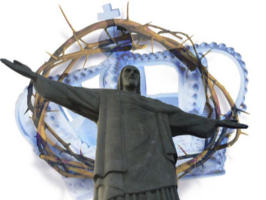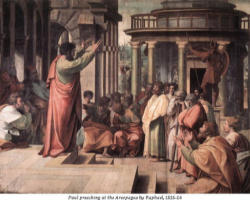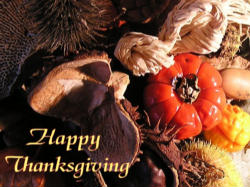 The Catholic liturgical year follows a rhythmic cycle which points us toward beginnings and ends. In doing so, it emphasizes an important truth that can only be grasped through faith. This past Sunday was the Thirty Fourth or last Sunday in the Western Church year and we celebrated the Feast of the Solemnity of Jesus Christ the Sovereign King. This week is the last week of the Church year.
The Catholic liturgical year follows a rhythmic cycle which points us toward beginnings and ends. In doing so, it emphasizes an important truth that can only be grasped through faith. This past Sunday was the Thirty Fourth or last Sunday in the Western Church year and we celebrated the Feast of the Solemnity of Jesus Christ the Sovereign King. This week is the last week of the Church year.
Then, no sooner than we have celebrated the last Sunday of the Year, the feast of Christ the King, we will celebrate the First Sunday of Advent, and begin the time of preparation for the great Feast of the Nativity of Our Savior. Our Catholic faith and its Liturgical practices proclaim to a world hungry for meaning that Jesus Christ is the “Alpha”, (the first letter of the Greek alphabet) and the “Omega” (the last letter), the beginning and the end. He is the Giver, the Governor and the fulfillment of all time. In Him the whole world is being made new and every end is a beginning.
Our Liturgical seasons present a way to receive time as a continual gift and change the way we actually live our daily lives. Our choice to celebrate them helps us to grow in the life of grace as we say “yes” to their invitations. They invite us to walk in a new way of life which becomes infused with supernatural meaning; to enter into the mystery of living in the Church as the New World and thereby become leaven in an age which has lost its soul. Human beings have always marked time by significant events. The real question is not whether we will mark time, but how we will mark time? What events and what messages are we proclaiming in our calendaring? What are we saying with our lives in an age which needs the witness of God’s loving plan?
For the Christian, time is not meant to be a tyrant, ruling over us. Nor is the passing of time to be experienced as an enemy, somehow stealing our youth and opportunity. Rather, time is meant to become a companion, a friend and a teacher, instructing us; offering us a series of invitations to allow the Lord to truly become our King by reigning in our daily lives. Our conscious awareness of time makes it a path along which the redemptive loving plan of a timeless God is revealed and received. In Christ, time is now given back to us as a gift. It offers us a field of choice and a path to holiness and human flourishing.
As we view time with this lens of faith, we discover that life is a pilgrimage to Life. The Lord invites us, beginning now, to participate in His loving plan through His Son Jesus to recreate the entire cosmos. Time becomes the road along which this loving plan of redemption proceeds. Those Baptized in Christ continue His redemptive mission until he returns to establish His Reign. We do this by living in His Body, the Church, and drawing the whole world into the New World beginning now.
The Christian view of time as having a redemptive purpose is why Catholic Christians mark time by the great events of the faith in our Liturgical calendar. Like so much else that is contained within the treasury of Catholic faith and life, the Church, who is an “expert in humanity”, invites us to live the rhythm of the liturgical year in order to walk into the deeper encounter at the heart of Catholic Christian faith. As we learn to “live liturgically”, moving through life in the flow of the liturgical calendar we can find the deeper mystery and meaning of life.
Christians believe in a linear timeline in history. There is a beginning and an end, a fulfillment, which is, in fact, a new beginning. Time is heading somewhere. That is as true of the history of the world as it is our own personal histories. Christians mark time by the great events of the Life, Death and Resurrection of Jesus Christ. We are always moving forward and toward His loving return.
The Church, to use the beautiful imagery of the early Christian fathers, was birthed from the wounded side of the Savior on the Cross at Calvary’s hill. This new family of the Church was then sent on mission, when, after the Resurrection, Jesus breathed His Spirit into them at Pentecost. In our celebration of a Church Year, we not only remember the great events of the Life, ministry and Mission of the Lord, we also celebrate the life and death of our family members, the Saints, who have gone on before us, in the worlds of the Liturgy, “marked with the sign of redemption.”
They are models and companions for the journey of life and are our great intercessors; that “great cloud of witnesses” (Hebrews 12:1) whom the author of the letter to the Hebrews extols. This is the heart of understanding the “communion of saints”. As St. Paul reminded the Roman Christians, not even death separates us any longer. (Romans 8:38, 39) They will welcome us into eternity. However, from that eternal now, living in the Communion of love, they now help us along the daily path of time through both their example and their prayer.
As we progress through liturgical time we are invited to enter into the great events of faith. So, on this last week of the year, through our readings and liturgical prayer, we are invited to reflect on the “last things”- death, judgment, heaven and hell. We do so in order to change, to be converted; to enter more fully into the Divine plan. The Western Church year ends. On the Feast of Christ the King we celebrated the full and final triumph and return of the One through whom the entire universe was created – and in whom it is being “recreated” – and by whom it will be completely reconstituted and handed back to the Father at the “end” of all time. That end will mark the beginning of a timeless new heaven and a new earth when “He will wipe every tear from their eyes, and there shall be no more death …” (Revelations 21:4).
As we now move from one Church year to the next, we also move along in the timeline of the human life allotted to each one of us. We age. The certainty of our own death is meant to illuminate our life and the certainty of the end of all time is meant to illuminate its purpose and culmination in Christ. For both to be experienced by faith we must truly believe in Jesus Christ, the beginning and the end. When we do, death can become, as we move closer to it, a second birth. Francis of Assisi prayed these words in his most popular prayer “… it is in dying that we are born to eternal life.” He referred to death as a “sister” implying that he had a relationship with it. So too did all the great heroes our Church, the saints. So can we, that is if we choose to walk the way of living faith, immersed in the life of grace.
With a few exceptions, Christians celebrate the death of Saints because death is not an end but the beginning of an eternal life with God. In the final book of the Bible we read: “Here is what sustains the holy ones who keep God’s commandments and their faith in Jesus. I heard a voice from heaven say, “Write this: Blessed are the dead who die in the Lord from now on.” “Yes,” said the Spirit, “let them find rest from their labors, for their works accompany them. Then I looked and there was a white cloud, and sitting on the cloud one who looked like a son of man, with a gold crown on his head and a sharp sickle in his hand. Another angel came out of the temple, crying out in a loud voice to the one sitting on the cloud, “Use your sickle and reap the harvest, for the time to reap has come, because the earth’s harvest is fully ripe. So the one who was sitting on the cloud swung his sickle over the earth, and the earth was harvested.” (Revelations 14: 12-15)
As the Apostle John recorded in that Revelation he received on the Island of Patmos, our “use” of time is meant to bear good fruit. We are called to bear a harvest which will accompany us into eternity. It will – if we have an intimate relationship with the One who both gives and governs time. Time is the opportunity for the Christian to bear that “fruit that remains” to which Jesus referred: “It was not you who chose me, but I who chose you and appointed you to go and bear fruit that will remain, so that whatever you ask the Father in my name he may give you. This I command you: love one another” (St. John 15: 16, 17).
We decide whether we will use time for the bearing of good fruit or allow it to become a tyrant who frightens us as we fruitlessly try to resist his inevitable claim on our perceived youth. This act of choosing rightly, daily, helps us to develop a disposition; a way of living that involves the proper exercise of our human freedom aided by grace. When time is perceived as a gift from God and welcomed as an opportunity for bearing the fruits of love and holiness, we learn to receive it in love and perceive it as a field of choice and an environment for holiness. We choose to fill our lives with love and pour ourselves out for the God of love. When we live this kind of life, Jesus can find a home within us from which He can continue His redemptive mission, in time.
The ancients were fond of a Latin phrase “Carpe Diem”, which literally means “Seize the day.” For we who are living in communion in Christ Jesus, that phrase can take on a whole new meaning. We always journey toward the “Day of the Lord”, when He will return as King. We should seize that day as the reference point for all things on this last week of the year and the Feast of Christ the King. We can live our lives as though His day is the milestone and marker for all that we do, revealing the path along which we become new. Almost two thousand years ago the ancient Greek writer, Seneca, wrote: “It is not that we have so little time, but that we have wasted so much of it” St. Paul wrote to Greek Christians, centuries later in Ephesus: “Look carefully then how you walk, not as unwise men (and women) but as wise making the most of the time…” (Ephesians 5: 15ff).
As we consider the timeline of God’s unfolding plan, the redemption of the whole cosmos, the God who gives and governs time, invites us to re-dedicate ourselves to living differently on this great Feast. We are to live as though time really does matter. We are invited by grace to give ourselves away for others; to imitate the One who gave Himself for the entire human race. We are invited to pour ourselves out as Jesus did. If we live life this way, when we face Him on that final day, we will do so with our arms full of gifts borne in time. These gifts will have paved the way for eternity.
That is why I suggest that it is no coincidence that the Feast of Christ the King and the last week of the year pass through the “secular” Feast of Thanksgiving. There is no separation for the believer between the secular and the Sacred. In the great event of the Incarnation and the fullness of the Paschal Mystery, all is made new. We do not bring God into time; He is the Creator of time. In the mystery of the Incarnation, the Eternal Word through whom the universe was created entered into time to re-create it from within! We are invited by grace to come to acknowledge this mystery and then receive his creature time as a gift, a good, to be given back to Him through living our lives in Christ for the sake of the world.
Thanksgiving is a great Feast made even fuller in meaning for the believing and practicing Christian. The word “Eucharist” means Thanksgiving. Let us walk through this last week of the year and join with those whom we love around the table of Thanksgiving, and then let us walk the way of faith into the new Liturgical season, Advent, getting ourselves and the world of our own time ready for the final coming of Christ the King. On this last week of the Church Year, let us remember that every end is a beginning because in Christ the King, Thanksgiving and Advent become a way of life.

